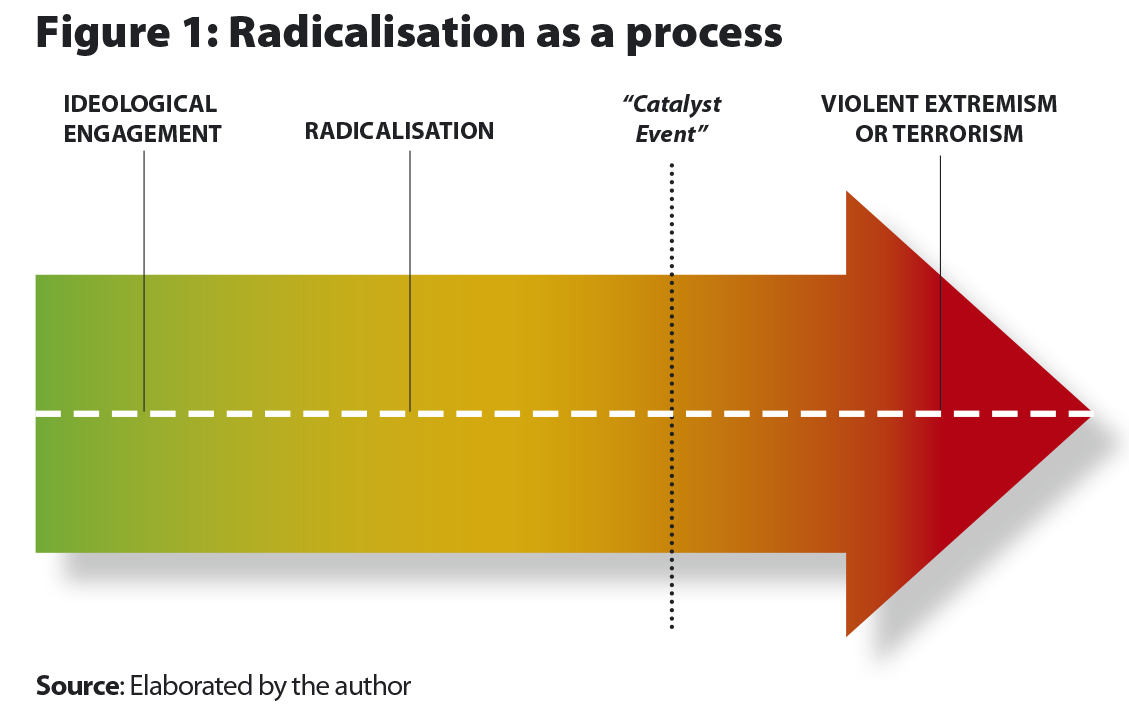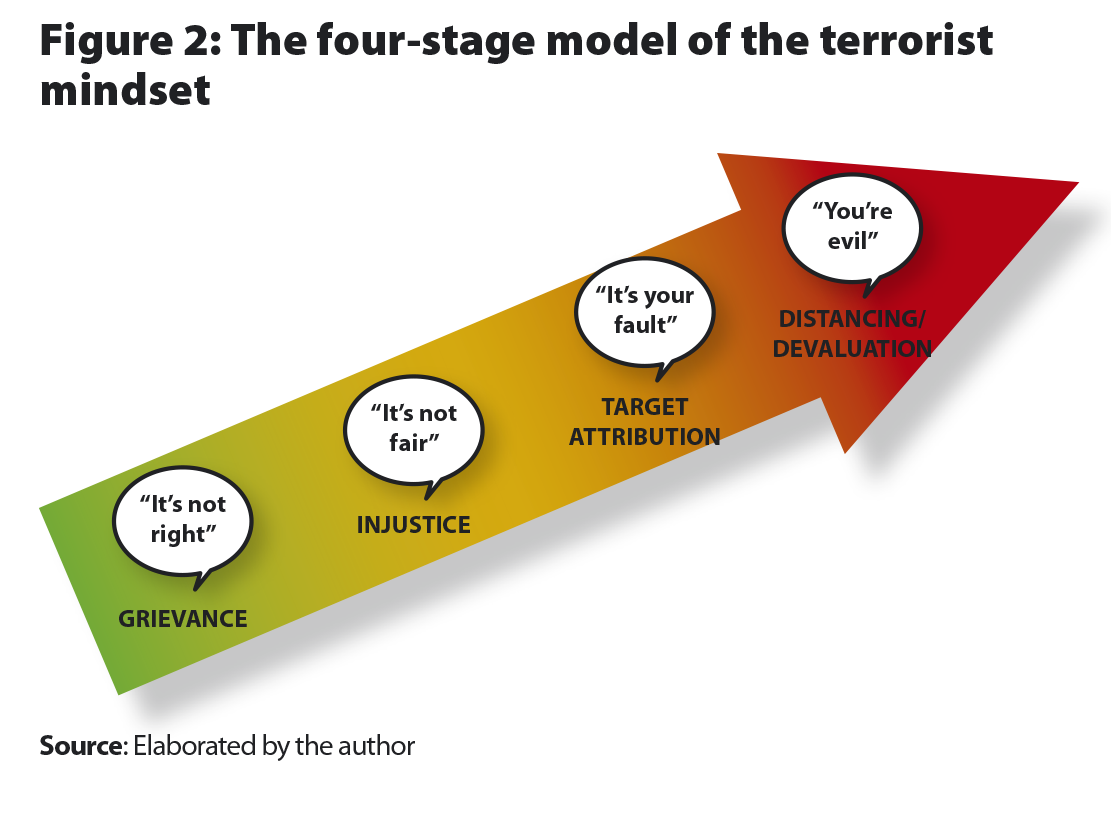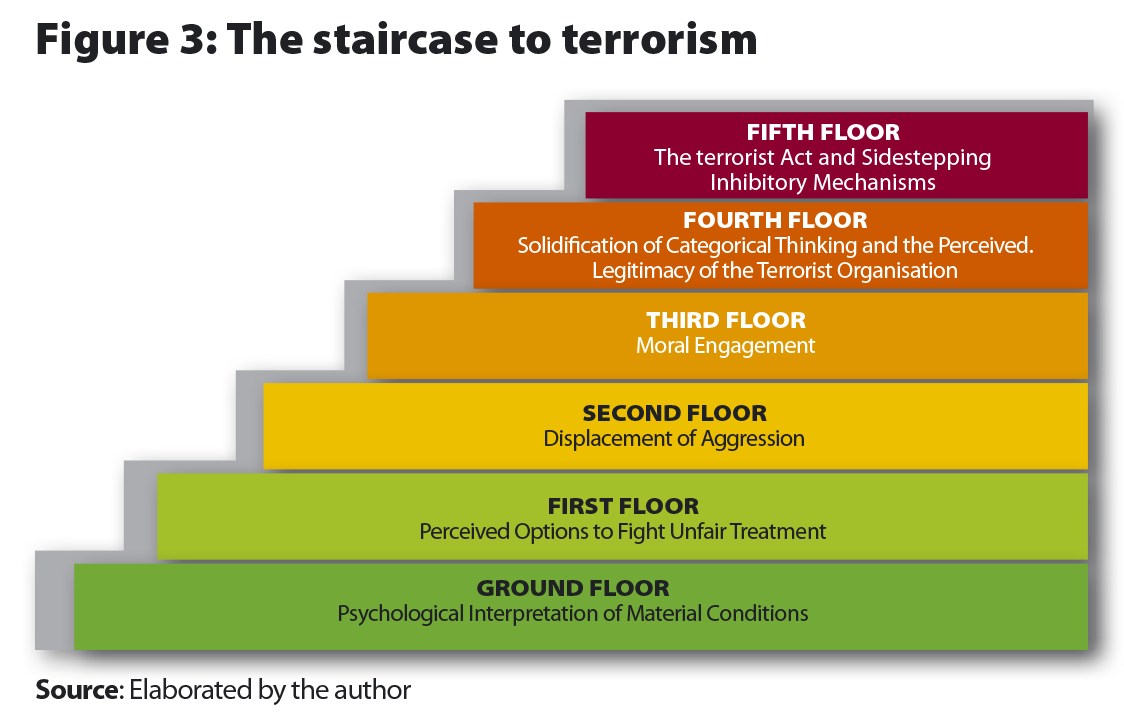What does Radicalisation Look Like? Four Visualisations of Socialisation into Violent Extremism

It is estimated that over 5,000 western Europeans have travelled to Iraq and Syria since fighting broke out in 2011. These foreign fighters have travelled to the Middle East to join the jihadist group Islamic State (often abbreviated as IS, ISIS, ISIL, or Daesh), a Salafist jihadist group that follows an ultraconservative branch of Sunni Islam. But what has driven these individuals to migrate to ISIS territory and serve the self-proclaimed Caliphate? Why have so many foreign fighters joined the ranks of Jihad? The underlying assumption is that the majority of European mujahideen have undergone a process of radicalisation and now believe that an offensive holy war is required to defend and expand Islam.
As the Islamic State surrenders territory as a result of international military intervention, there has been much debate in academic and policy circles about how ISIS fighters, particularly foreign fighters, will respond. Western security agencies worry that these combatants will return to their home countries or venture into neighbouring countries to launch attacks; there is concern about whether some of these fighters and their spouses can be reintegrated into society; and there is also concern about what to do with all of the children born in ISIS territory, who may soon be stateless kids because of a lack of proper documentation on marriages and births. Having the ability to identify, detain and prosecute radicalised returnees would be of great help to law enforcement agencies.
Credible information indicates that the next stage of violent jihad might be fought on European soil. But how should Western governments deal with arrested foreign fighters or returnees upon their return? What is the difference between a radicalised individual and a common criminal? Are authorities attuned to what the process of radicalisation looks like? The goal of this piece is to examine violent radicalisation as a much discussed but little understood process and provide a visual representation of four models that depict the process of radicalisation towards violent extremism that manifests itself in terrorism.
What is radicalisation?
Whereas not all radicals are terrorists, all terrorists are radicals. Individuals living in representative democracies are entitled to hold ideas that tackle the roots of issues (the literal meaning of radical) as well as to favour drastic political, economic or social reforms. In fact, many of the causes defended by European “radical movements” in the late 19th and early 20th century were gradually assimilated by the orthodoxy of political liberalism (widening the franchise, redistributing property, freedom of the press, etc.). This might explain why liberal constitutions protect the rights of citizens to defend extreme or unorthodox views and only limit the freedom of speech when this is obscene, offensive or advocates violence. However, the rules that govern the world of ideas and the world of actions could not be more different. The behaviour of individuals is tightly regulated, especially when it involves the use of illegitimate violence against non-combatants that is not sanctioned by the state. Open societies are intolerant (and rightly so) of individuals and organisations that use indiscriminate violence against civilians.
The term “radicalisation” is often used by pundits and experts when discussing Salafists, the ultra-conservative Islamists who are known for aggressive proselytising and their sympathies for ISIS and Al-Qaeda. But the process of radicalisation is present in all kinds of terrorism, whether left-wing, right-wing, anarchist, ethno-nationalist or religious. Although the need is urgent to tackle the violent manifestation of radicalism, it is also important to separate this from ideology, which is not violent per se. People, not ideologies, are violent. At the same time, there are ideologies that explicitly advocate the use of non-state violence to accomplish long-term goals and these are more likely to appeal to terrorists. As Peter Neumann has convincingly argued, the real long war entails delegitimising extremist movements and engaging with the ideas, political conflicts and social cleavages that make them resonate (2016: xviii).
There are many definitions of radicalisation but this piece is specifically interested in the process by which individuals “radicalise to violence”. And not to just any type of violence, but to a specific type of political violence, namely illegitimate violence directed against civilians and non-combatants, also known as terrorism. As argued by Schmid, what is generally meant by radicalisation is the “individual or group process of growing commitment to engage in acts of political terrorism” (Schmid, 2013: 1). Finally, a working definition of “violent radicalisation” is provided by the European Commission’s Expert Group on Violent Radicalisation which has defined it as “socialisation to extremism which manifests itself in terrorism” (Expert Group, 2008: 7).
While violent radicalisation has gradually moved to the top of the EU counter-terrorism agenda, it has been accompanied by a relatively embryonic understanding of the processes and interplay of factors that contribute to the adoption of radical ideas and behaviour. The term “radicalisation” was brought into the policy discussion after the coordinated suicide bombing attacks in Madrid (2004) and London (2005) which targeted civilians using the public transport system and resulted in 191 and 52 casualties respectively. Several of the attackers in both incidents were home-grown terrorists which had either been born or socialised in the country and had adopted a new identity in which the struggles of their Muslim homelands played a powerful role in fomenting anger against the West. For the authorities, it soon became a priority to have a clearer picture of how young men from Muslim immigrant backgrounds radicalised in the West and were swept up by a seductive outlaw culture of violent Jihad.
What does radicalisation look like?
The adoption of radical ideas is a mental process that is hard to detect. In the case of Islamist terrorism, law enforcement agencies often look for “signs” that may reveal a change of ideas, such as suddenly adopting more religious clothes, growing a beard, introversion, secrecy, cutting links with old networks of friends, or visiting some far-off conflict zone. These behavioural changes are useful to the operational goal of detecting and preventing the process of radicalisation but they tell us very little about the acquisition of new knowledge and understanding by an individual. The goal of this piece, however, is to provide visualisations of four analytical models of radicalisation which, to reiterate, are common to all types of terrorism.
Radicalisation as a process
About the only thing radicalisation experts agree on is that radicalisation is a process (Schmid, 2013: 1). As indicated in Figure 1, a basic understanding of this cognitive process would entail the gradual adoption of extremist ideas and would end, if completed, in the practice of violent extremism or terrorism.

Figure 1 indicates that radicalisation is best viewed as a process of change, a personal and political transformation from one condition to another. Becoming radicalised is a gradual process and one that requires progression through distinct states and happens neither quickly nor easily. Thus, a person does not become a radical overnight although the influence of a “catalyst event” may accelerate the process.
The catalyst event has been described by Quintan Wiktorowicz (2004; 2005) as a “cognitive opening” which makes a person more receptive to the possibility of new ideas and world views. This shocking event or personal crisis shakes an individual’s certitude in previously held beliefs, prompts them to re-assess their entire life and become open to a radical change of values and behaviour. In the case of the IRA or ETA, new recruits justified joining the ethnonationalist terrorist groups by referring to the killing (or torturing) of friends and relatives by the state, and it may therefore be assumed that terrorism was an act of vengeance. More recently, there is evidence that criminals who joined jihadist groups like ISIS and Al-Qaeda realised that their criminal behaviour had been harmful and that they needed to break with their past and make up for their “sins”. This “point of no return” provided the rationale for their turn to religion and justified the involvement with Salafist followers of the ultraconservative Sunni branch of Islam.
The catalyst event can take multiple forms: economic (losing a job, blocked social mobility), social (alienation discrimination, racism), political (international conflicts) and personal (death of a loved one). In addition, there is a long list of triggers (real or perceived) which may initiate the progressive movement towards violent extremism. In short, it is not difficult to find individuals who are being deprived of something to which they feel entitled.
The Four-Stage Model
The sketch provided above seems intuitively correct but a richer picture that identifies the different phases of the process of radicalisation is required. A more elaborate model that tries to chart the transition from early involvement to becoming operationally active is the Four-Stage Model proposed by Randy Borum (2003; 2011). Borum proposes a conceptual model for the emergence of a “terrorist mindset” and argues that there are some common factors to all processes of radicalisation to violence. His model attempts to explain how grievances and vulnerabilities are transformed into hatred of a target group, and how hatred is transformed – for some at least – into a justification or impetus for violence. Or, to put it differently, the model explains how relative deprivation and moral outrage are combined to allocate responsibility for an alleged injustice and vindicate terrorist action.
As Figure 2 indicates, the four-stage process begins by identifying some unsatisfying event, condition, or grievance (“It's not right”) and framing it as being unjust (“It's not fair”). For example, specific events such as the wars in Bosnia, Chechnya, Afghanistan and Iraq are inserted into a wider interpretation of the world where moral violations are seen as representing a “war against Islam”. The third stage involves blaming the injustice on a target policy, person, or nation (“It's your fault”) and the fourth and final stage involves identifying, vilifying and even demonising the responsible party (“You're evil”), which facilitates the justification of or impetus to aggression. The model successfully describes the progression involved in a process of ideological radicalisation but is unable to forecast when individuals will take the ultimate step of using indiscriminate political violence.

Similar models to Borum’s have been developed by police forces (e.g. the NYPD) to help their members chart the trajectory of individuals who become terrorists. Identifying the cause that impels some individuals to violent action also gives clues as to how these stages reinforce each other and about what the process of recruitment may involve, as well as operational clues on how to develop a counter-recruitment strategy. However, these law enforcement models have modest ambitions (e.g. training) and do not identify the multiple causes that enhance the likelihood of an individual being drawn to a terrorist group.
Staircase to Terrorism
A more sophisticated model is provided by Georgetown University psychology professor Fathali M. Moghaddam (2005), who developed the “Staircase to Terrorism” as a metaphor for the process of violent radicalisation. Moghaddam’s metaphor is of a staircase housed in a building where everyone lives on the ground floor, but where an increasingly small number of people ascend to the higher floors, and very few reach the top of the building. The “staircase” narrows as it ascends from the ground floor and fewer and fewer people reach each of the five successive floors.

Feelings of discontent and perceived adversity form the foundation of the staircase and the fuel for initially setting out on the path to terrorism. The ground floor is heavily populated by those who perceive some form of injustice or deprivation. Those who wish to do something about it climb to the first floor. The second floor, not as populated, accommodates those who, having found no solutions to their problems, displace their aggression onto some enemy. The third floor harbours those fewer people who join a group facilitating a kind of moral engagement before they ascend to the fourth floor, where “recruitment to terrorist organisations takes place”. Then, finally, the fifth floor, where they are trained to “sidestep inhibitory mechanisms” and sent to kill. “As individuals climb the staircase”, Moghaddam writes, “they see fewer and fewer choices, until the only possible outcome is the destruction of others, or oneself, or both”. Once again, the model was designed with a specific purpose in mind, in this case explaining suicide bombing, and it is entirely possible that the five stages cannot be generalised to a wide universe of cases.
The Pyramid Model of Radicalisation
Finally, the most elaborate visualisation is provided by the so-called Pyramid Model of Political Radicalisation where the higher levels of the pyramid are associated with increased commitment but decreased numbers are involved. As Figure 4 indicates, the apex of the pyramid represents the small number of active terrorists who remain relatively few in number when considered in relation to all those who may sympathise with their beliefs and feelings (e.g. superiority, injustice, distrust, vulnerability, etc.). The lower level of activists is composed of those who are not committing violent acts themselves, but provide those sitting at the top with tacit support (e.g. recruitment, political or financial support, etc.). The level below is made up of the far larger group of supporters who justify the goals the terrorists say they are fighting for but also, crucially, the violent means. The base of the pyramid is made of a far larger group of sympathisers who agree with the goals the terrorists say they are fighting for. This wider community of reference would constitute the social group the terrorist group is claiming to represent.

From the pyramid perspective, radicalisation is the gradient distinguishing the active terrorists from the broader base of sympathisers. The number of members and intensity of support for/dedication to the political cause increases with each level and the more behaviourally committed – as indicated by their willingness to take risks – sit at the top. The model leaves open the question of how a person moves from the base to the extremes of the apex, an element that is best studied in the Borum and Moghaddam models. The interesting aspect of this model is that it moves away from the individual level and introduces the role of ideologies or “frames” linking the terrorists with their societies at large. In order to understand militants, it is important to pay attention to “group identification” or the way terrorists care “about what happens to the group, especially in relation with other groups” (McCauley & Moskalenko, 2008: 416).
The authors of the model are Clark McCauley and Sophia Moskalenko, two psychologists who conceptualise “political radicalisation as change in beliefs, feelings, and action toward support and sacrifice for intergroup conflict” (2008: 428). An interesting observation from their work, however, is that many of the mechanisms of radicalisation of individuals and groups are largely reactive. The drivers are not intrinsic to specific individuals but are found in the contexts they inhabit. This is essentially a relational approach and the radicalisation of non-state groups can be interpreted as a response to the actions of other actors. In the words of McCauley and Sophia: “political radicalization of individuals, groups, and mass publics occurs in a trajectory of action and reaction in which state action often plays a significant role. Radicalization emerges in a relationship of intergroup competition and conflict in which both sides are radicalized. It is this relationship that must be understood if radicalization is to be kept short of terrorism”.
Conclusion
The four visualisations presented above are suggestive of what the process of radicalisation might look like. From the simpler to the more comprehensive, the incremental complexity of these figures indicates seven lessons to be taken into account when detecting and countering radicalisation towards violent extremism.
1- Terrorists and radicalised groups resemble an iceberg. Only a small minority of radicals use strategic violence to attract media attention. The majority of extremists are not visible and use non-violent methods, which are more effective in achieving their stated goals. Below the water level, there is a support base which occasionally agrees with the actions of the most committed militants and an even larger “silent minority” with a distaste for targeting non-combatants. Counter-terrorism must target the visible part of the iceberg, whereas counter-radicalisation needs to aim at the underwater section of the iceberg, which is much larger. Not the other way around.
2- Individuals are drawn into a clandestine life by their devotion to a cause. Living underground can be a grim experience and not everyone is equally motivated in finding a rationalisation for violence. Terrorists go through a “catalyst event” and risk their life to further a greater cause, which may be political, religious, social, etc. Thus, the most effective counter-recruitment policy is to deploy a targeted counter-terrorist policy that increases the costs of joining a terrorist group while providing channels for dealing with the “issues” raised by its sympathisers.
3- Radicalisation and mental pathologies do not go hand in hand. Terrorist organisations tend to recruit disciplined individuals who can follow orders and do as they are told. The unpredictable, the unstable and the traumatised are weeded out. As suggested by the “staircase model”, an individual will progress into a terrorist group in a slow and gradual manner, with would-be terrorists given smaller tests before being trusted in more important missions, and with many non-violent tasks before being asked to use guns or explosives. The most common characteristic of terrorists is their normality.
4- Self-radicalisation is rare. Even autonomous self-starters who radicalise on the internet need social interaction with a long-distance recruiter. Evidence points to the importance of neighbours, cliques of friends, and relatives in explaining indoctrination. The progressive intensification of radical beliefs is still bound by territory and is very context dependent. Furthermore, radicalisation with like-minded people rarely occurs in the virtual space and more often takes place in cities and neighbourhoods which act as fertile grounds in which to harden ideological positions.
5- Radicalisation is a multi-level process, as suggested by the pyramid model. Individuals are at the centre of this socialisation process but what goes in the sociopolitical environment and surrounding organisations also matters. A comprehensive strategy to counter radicalisation needs to take into account the individual, organisational and societal level. Given the multiplicity of causes at play, it is not possible to identify a single causal mechanism or “terrorist mindset”.
6- Indiscriminate murder might be too complex a subject to synthesise in a single model. In fact, the causes of radicalisation are as diverse as they are abundant and there is no single theory that can integrate all the triggers of radicalisation. Factors contributing to violent radicalisation processes can be: familial, social, gender-based, socioeconomic, psychological, religious, ideological, historical, cultural, political, propaganda, social media or internet-based. The events and conditions leading a person from radical ideas to violent action are also numerous, and the mechanisms are so complex that they need to be broken down to be understood. Hence, there is a clear need to incorporate a multi-level understanding of radicalisation that covers individuals, groups and the mass public and tries to specify the interactions between them.
7- An effective counter-narrative that can prevent support for intergroup conflict needs societal introspection and the fine-tuning of state policies. Western publics should demand the highest standards on both domestic and foreign policy to leave terrorist sympathisers with no arguments. Advanced democracies with high ethical standards are more resilient and better prepared to resist the challenge of violent extremism, either from inside or outside. However, introspection and self-criticism should not result in self-doubt or inaction against global jihadism. Instruments of counter-radicalisation need to be deployed on those who sympathise with extremism whereas the full force of counter-terrorism needs to fall on those who want to destroy political authority with illegitimate violence.
References
Borum, Randy. “Understanding the Terrorist Mind-Set”, FBI Law Enforcement Bulletin, 72:7, (2003), pp. 7-10.
Borum, Randy. “Radicalization into Violent Extremism II: A Review of Conceptual Models and Empirical Research”, Journal of Strategic Security, 4:4, (2011), pp. 37-6.
Christmann, Kris. Preventing Religious Radicalisation and Violent Extremism. A Systematic Review of the Research Evidence. Research Report. Youth Justice Board, (2012).
Clark McCauley and Sophia Moskalenko. “Mechanisms of Political Radicalization: Pathways Toward Terrorism”, Terrorism and Political Violence, 20:3, (2008), pp.415-433.
Moghaddam, Fathali. “The Staircase to Terrorism”, American Psychologist, 60: 2, (2005), pp.161-169.
Neumann, Peter R. Radicalized. New Jihadists and the Threat to the West. London & New York: I.B. Tauris, (2016).
Schmid, Alex P. Radicalisation, De-Radicalisation, Counter-Radicalisation: A Conceptual Discussion and Literature Review. ICCT Research Paper, (2013).
Wiktorowicz, Quintan. “Joining the Cause: Al-Muhajiroun and Radical Islam”, The Roots of Radical Islam, Department of International Studies, Rhodes College, (2004).
Wiktorowicz, Quintan. Radical Islam Rising: Muslim Extremism in the West. London: Rowman & Littlefield, (2005).
E-ISSN: 2013-4428
D.L.: B-8439-2012